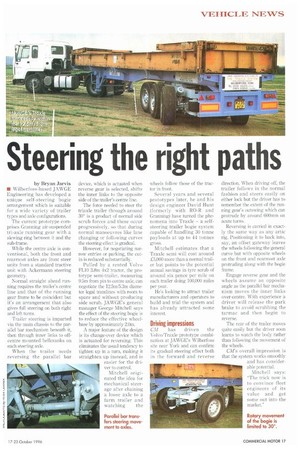Steering the right paths
Page 19

If you've noticed an error in this article please click here to report it so we can fix it.
by Bryan Jarvis • Wilberfoss-hased JAWGE Engineering has developed a unique self-steering bogie arrangement which is suitable for a wide variety of trailer types and axle configurations.
The current prototype comprises Granning air-suspended tri-axle running gear with a slewing ring between it and the sub-frame.
While the centre axle is conventional, both the front and rearmost axles are front steer units from a standard tractive unit with Ackermann steering geometry.
Normal straight ahead running requires the trailer's centre line and that of the running gear frame to be coincident but it's an arrangement that also gives full steering on both right and left turns.
Trailer steering is imparted via the main chassis to the parallel bar mechanism beneath it, then through inner links to offcentre mounted bellcranks on each steering axle.
When the trailer needs reversing the parallel bar device, which is actuated when reverse gear is selected, shifts the inner links to the opposite side of the trailer's centre line.
The force needed to steer the triaxle trailer through around 300 is a product of normal side scrub forces and these occur progressively, so that during normal manoeuvres like lane changing or following curves the steering effect is gradual.
However, for negotiating narrow entries or parking, the cutin is reduced substantially.
Pulled by a rented Volvo FL 10 3.8m 1x2 tractor, the prototype semi-trailer, measuring 9.5m from pin to centre axle, can negotiate the 12.5m15.3m diameter legal tramlines with room to spare and without producing side scrub. JAWGE's general manager George Mitchell says the effect of the steering bogie is to reduce the effective wheelbase by approximately 2.0m.
A major feature of the design is its change-over device which is actuated for reversing. This eliminates the usual tendency to tighten up in a turn, making it straighten up instead, and is easier for the driver to control.
Mitchell originated the idea for mechanical steerage after chaining a loose axle to a farm trailer and watching the wheels follow those of the tractor in front.
Several years and several prototypes later, he and his design engineer David Hunt (formerly with RO-R and Granning) have turned the phenomena into Traxle — a selfsteering trailer bogie system capable of handling 30 tonne payloads at up to 44 tonnes gross.
Mitchell estimates that a Traxle semi will cost around £5,000 more than a normal trailer but points to the potential annual sayings in tyre scrub of around six pence per mile on each trailer doing 100,000 miles per year.
He's looking to attract trailer manufacturers and operators to build and trial the system and has already attracted some interest.
Driving impressions
CM has driven the Volvo/Traxle prototype combination at JAWGE's Viiilberfoss site near York and can confirm its gradual steering effect both in the forward and reverse direction. When driving off, the trailer follows in the normal fashion and steers easily on either lock but the driver has to remember the extent of the running gear's outswing which can protrude by around 600mm on acute turns.
Reversing is carried in exactly the same way as any artic rig. Positioning it to back into, say, an offset gateway leaves the wheels following the general curve but with opposite wheels on the front and rearmost axle protruding along with the bogie frame.
Engage reverse gear and the wheels assume an opposite angle as the parallel bar mechanism moves the inner links over-centre. With experience a driver will release the park brake to avoid scrubbing the tarmac and then begin to reverse.
The rear of the trailer moves quite easily but the driver soon learns to watch the body rather than following the movement of the wheels.
CM's overall impression is that the system works smoothly and has considerable potential.
Mitchell says: "The trick now is to convince fleet engineers of its value and get some out into the market."




















































































































